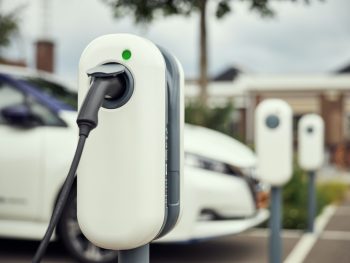UPDATED: Workplace chargers nearly doubles UK’s electric charging infrastructure
The UK has almost as many workplace charge points as public chargers for electric vehicles in the UK – nearly doubling the amount of infrastructure available to drivers.

The T&E study finds there are 33,000 charge points at UK workplaces
A recent study commissioned by campaign group Transport & Environment found there are 33,000 charge points at work, uplifting the public charging network by an additional 85%.
And with over a third of car and van miles being made for commuting and business purposes, the group says more landowners should install charging where people work – it’s calling on the Government to step in to enforce this.
While new legislation announced late last year and coming into effect from 15 June will require new homes and buildings such as supermarkets and workplaces to install charge points, T&E wants the Government to go further.
Ralph Palmer, UK electric vehicles & fleets officer, said: “Workplace chargers play a key role in the country’s transition to electric. That’s why the Government should require all non-residential sites to install charging stations so that workers can readily have their vehicle charged for their commute home.”
The fleet sector has also spoken out in recent years on the need for workplace charging to support drivers going electric – research carried out by vehicle charging specialist Ctek last year found that the availability of reliable chargers at destinations including workplaces is becoming increasingly paramount as more drivers switch to electric vehicles.
And Arval has said that workplace charging should be considered as part of a broader focus on EV adoption by the whole employee base, not just fleet drivers.
T&S’s research also found that charge point installation rates are increasing in line with the growth of the electric vehicle fleet – flying in the face of those saying the current network is not sufficient.
Its analysis shows 7,600 public chargers were installed in the last year – and that the existing public network has enough charge points for the number of battery electric vehicles (BEVs) currently on the roads in the UK. As long as the installation rates continue at pace, T&E says the country will be more than ready for higher targets to be adopted in the UK’s proposed Zero Emission Vehicle Mandate – currently still under consultation.
Ralph Palmer added: “The numbers are proving sceptics wrong: the British people are moving to electric vehicles and there are enough charging stations available to help them in their transition.”
But the study finds that regional distribution of charging points is still an issue. Unsurprisingly, London surges far ahead for the number of chargers installed per region. Conversely, Northern Ireland is not only the lowest in the absolute number of chargers already installed, but it is also adding them at a slower rate than any other region (8% growth in 2021, compared to a 49% growth in London).
The research chimes with latest data from the Department for Transport on regional disparities – and T&E says the priority for the Government should be to ensure regions don’t get left behind ahead of the expected surge in numbers of electric vehicles, including adopting a more targeted approach to charge point rollout in its Electric Vehicle Infrastructure Strategy.
Unveiled earlier this year, the stategy sets a target for the UK to have 300,000 charge points by 2030 – up tenfold and supported by a new £450m Local Electric Vehicle Infrastructure (LEVI) fund for local authorities to use to expand charge point provision in their area.
But T&E says that setting a topline target and throwing money at it is “not a sufficient strategy to deliver a fit-for-purpose network” – and adds that the Government should ensure the charging network meets the needs of all types of drivers and provide sufficient coverage across all regions.
“It’s not enough to throw money at local authorities without a clear strategy. The Government needs to level up its charging network and ensure sufficient coverage from Land’s End to John o’ Groats. Interim targets and clear policy guidance must be provided by central Government to ensure success,” Ralph Palmer finished.
* This story has been updated. The original research stated there were more workplace chargers than public chargers but had been counting sockets for workplaces and charge points for public chargers.

